Impressionnant comme setup d'observation en spectroscopie !!!!
C'est finalement le système idéal pour faire à la fois de l'observation en haute résolution et basse résolution en ayant 2 spectrographes différents et complémentaires.
Coté stabilité du spectrographe echelle, est ce que vous l'avez régulé en température pour éviter les dérives ?
Il n'est certe pas embarqué sur le télescope, ce qui évite déjà les flexions mécaniques inévitables, mais il peut dériver selon la variation de la température ambiante durant les observations (peut sensible sur l'ALPY 600 mais sans doute beaucoup plus avec le spectrographe echelle avec une résolution de 11000)
New eshel setup in Chile
-
Olivier GARDE
- Posts: 1253
- Joined: Thu Sep 29, 2011 6:35 am
- Location: Rhône Alpes FRANCE
- Contact:
Re: New eshel setup in Chile
Pour l'instant au Chili, notre spectrographe eShel est juste installé dans une petite armoire faite tout spécialement pour lui
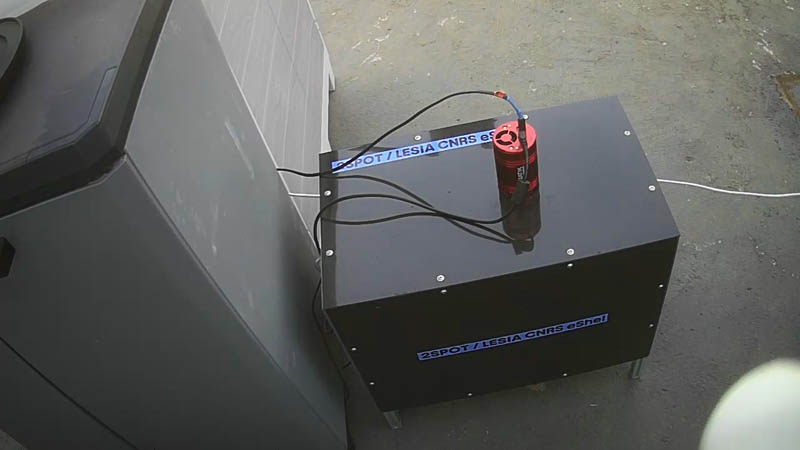
La variation de température durant une même nuit au Chili est très faible ce qui donne une très bonne stabilité thermique "naturelle".
Sur le spectrographe on a installé une sonde en température qui nous donne la valeur de la température du spectro en début et fin de pose (Module MG Box : https://www.astromi.ch/product/mbox/),
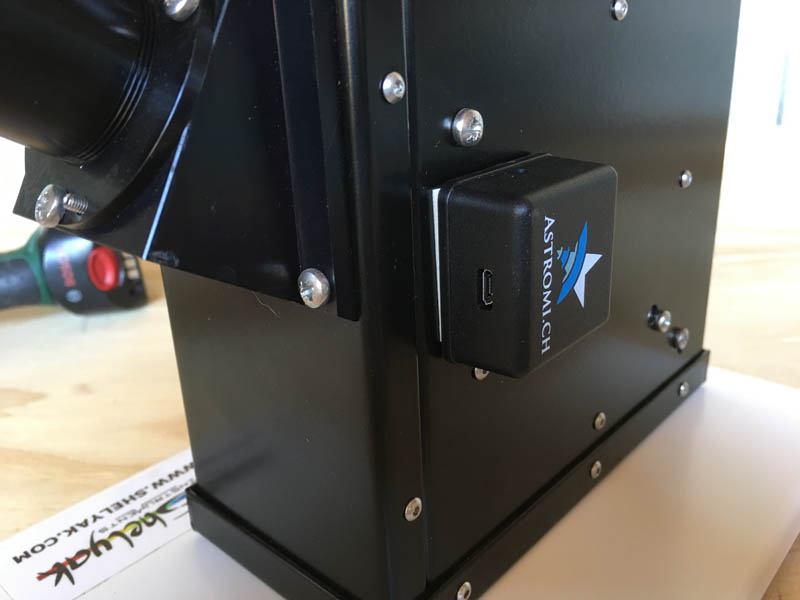
ce qui nous permet d'estimer la variation de température sur une même cible et donc avec une même lampe de calibration. Le flux du ventilateur de la caméra est à l'extérieur de l'armoire, comme cela la chaleur de la caméra ne vient pas augmenter la température du spectrographe.
Mais si un jour on se lance dans des mesures beaucoup plus précise en terme de vitesse radiale alors on lui fera une enceinte régulée en température.

La variation de température durant une même nuit au Chili est très faible ce qui donne une très bonne stabilité thermique "naturelle".
Sur le spectrographe on a installé une sonde en température qui nous donne la valeur de la température du spectro en début et fin de pose (Module MG Box : https://www.astromi.ch/product/mbox/),

ce qui nous permet d'estimer la variation de température sur une même cible et donc avec une même lampe de calibration. Le flux du ventilateur de la caméra est à l'extérieur de l'armoire, comme cela la chaleur de la caméra ne vient pas augmenter la température du spectrographe.
Mais si un jour on se lance dans des mesures beaucoup plus précise en terme de vitesse radiale alors on lui fera une enceinte régulée en température.
LHIRES III #5, LISA, e-Shel, C14, RC400 Astrosib, AP1600
http://o.garde.free.fr/astro/Spectro1/Bienvenue.html
http://o.garde.free.fr/astro/Spectro1/Bienvenue.html
Re: New eshel setup in Chile
Detection of a new outburst this morning on V862 Sco (accessible from the northern hemisphere). There was only one spectrum in the Bess database made by Christian Buil in 2008 with the same eshel spectrograph from the Pic du Midi on the T60 telescope. This spectrum made 15 years ago shows an absorbing H alpha line and this morning the spectrum made from Chile shows a slight emission.
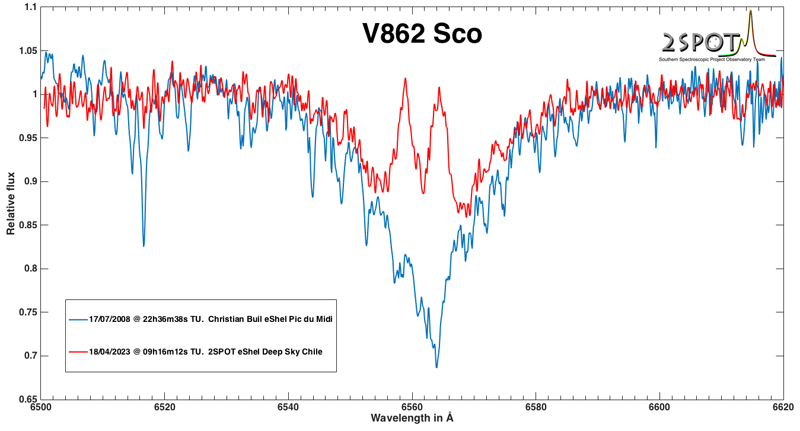
Graph not corrected from barycentric velocity.
We also follow a series of spectroscopic binaries like here HIP 65474 (Alf Virg).
Here there are only 2 measurements, so not enough to determine the precise period but it shows the Dopller shift that can be seen in 6 days (the period is about 4 days).
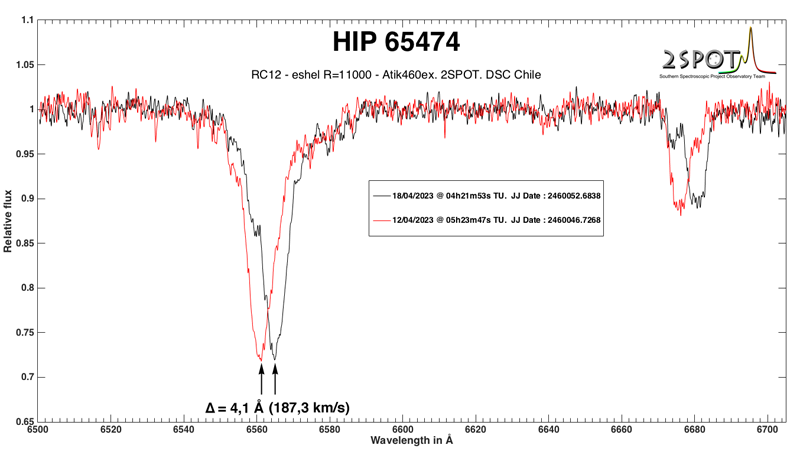
This graph is corrected from barycentric velocity.
And here are 2 pictures of our setup at dawn this morning, before the hangar was closed and before parking the mount.
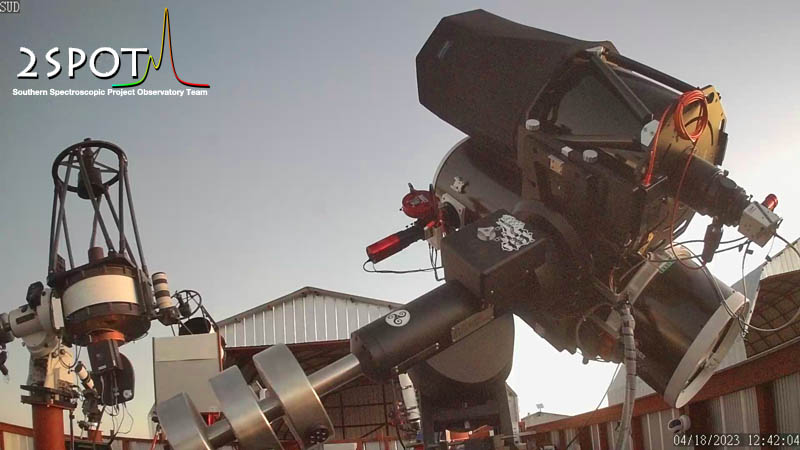
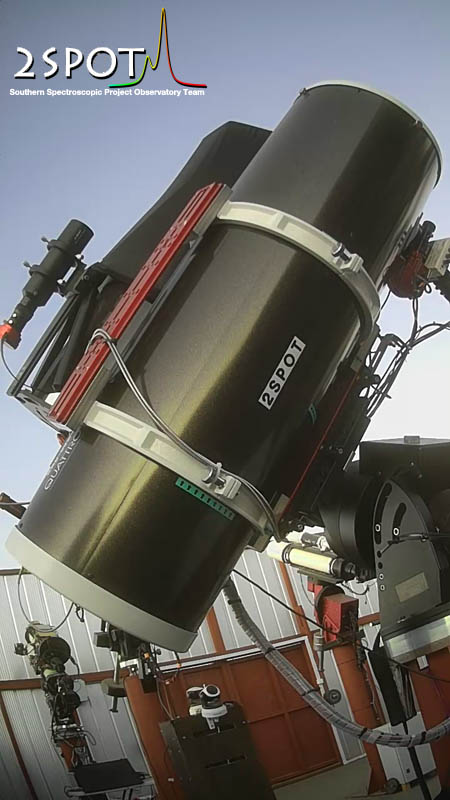

Graph not corrected from barycentric velocity.
We also follow a series of spectroscopic binaries like here HIP 65474 (Alf Virg).
Here there are only 2 measurements, so not enough to determine the precise period but it shows the Dopller shift that can be seen in 6 days (the period is about 4 days).

This graph is corrected from barycentric velocity.
And here are 2 pictures of our setup at dawn this morning, before the hangar was closed and before parking the mount.


2SPOT : Southern Spectroscopic Project Observatory Team
Website : http://www.2spot.org - Observatory Site : Deep Sky Chile https://www.deepskychile.com/fr/
Suport our action : https://www.helloasso.com/associations/ ... mulaires/2
Website : http://www.2spot.org - Observatory Site : Deep Sky Chile https://www.deepskychile.com/fr/
Suport our action : https://www.helloasso.com/associations/ ... mulaires/2
-
Bernard Heathcote
- Posts: 85
- Joined: Mon Sep 26, 2011 10:09 am
Re: New eshel setup in Chile
Well done Olivier and 2SPOT ... reliable and successful remote operations are a challenge!
Is your eShel operation fully automatic or manually remote? In other words is the location and positioning of the target star on the 50um fiberoptic 'slit' completely automated? If yes, can I ask what setup, hardware and software, you are using to achieve this?
Cheers,
Bernard
Is your eShel operation fully automatic or manually remote? In other words is the location and positioning of the target star on the 50um fiberoptic 'slit' completely automated? If yes, can I ask what setup, hardware and software, you are using to achieve this?
Cheers,
Bernard
-
Stephane Charbonnel
- Posts: 70
- Joined: Thu Sep 29, 2011 10:20 pm
- Location: FR, 49 ou 44
Re: New eshel setup in Chile
Hello Bernard,
I am Stephane Charbonnel, a member of the 2SPOT Team.
It is me who writes script for automatic observations.
Automatic observations are done exclusively via PRiSM software.
The principle is as follows:
1/ Choice of target in an ordered list or if the list is too long (like the list of Be stars), a Python algorithm takes care of the work according to the priorities internal to the instrumentation (and choice of team).
2/ Pointing of the field and recognition.
3/ The target is centered into the mirror hole by guiding.
4/ Once this intensive guiding is finished, it is guiding from a star which is not the spectral target.
5/ Thorium ...
and so on.
In fact, the script uses procedures during manual observations.
Regards.
I am Stephane Charbonnel, a member of the 2SPOT Team.
It is me who writes script for automatic observations.
Automatic observations are done exclusively via PRiSM software.
The principle is as follows:
1/ Choice of target in an ordered list or if the list is too long (like the list of Be stars), a Python algorithm takes care of the work according to the priorities internal to the instrumentation (and choice of team).
2/ Pointing of the field and recognition.
3/ The target is centered into the mirror hole by guiding.
4/ Once this intensive guiding is finished, it is guiding from a star which is not the spectral target.
5/ Thorium ...
and so on.
In fact, the script uses procedures during manual observations.
Regards.
-
Bernard Heathcote
- Posts: 85
- Joined: Mon Sep 26, 2011 10:09 am
Re: New eshel setup in Chile
Hi Stephane,
Thank you for your explanation. I also have PRISM but never mastered all it capabilities. I only used the basic imaging module and then abandoned it for Demetra (eShel) ... but I still use ISIS for processing. If I ever decide to automate my eShel acquistion, unlikely, you may have me calling on your experience!
Regards,
Bernard
Thank you for your explanation. I also have PRISM but never mastered all it capabilities. I only used the basic imaging module and then abandoned it for Demetra (eShel) ... but I still use ISIS for processing. If I ever decide to automate my eShel acquistion, unlikely, you may have me calling on your experience!
Regards,
Bernard